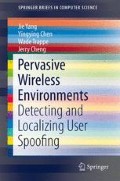Abstract
We provide a brief overview of identity-based spoofing attack, and its impact to the wireless and sensor networks in this chapter.
As more wireless and sensor networks are deployed, they will increasingly become tempting targets for malicious attacks. Due to the shared nature of the wireless medium, attackers can gather useful identity information during passive monitoring and further utilize the identity information to launch identity-based attacks, in particular, the most harmful but easy to launch attack: spoofing attacks.
Access this chapter
Tax calculation will be finalised at checkout
Purchases are for personal use only
References
J. Bellardo and S. Savage, “802.11 denial-of-service attacks: Real vulnerabilities and practical solutions,” in Proceedings of the USENIX Security Symposium, 2003, pp. 15–28.
W. A. Arbaugh, N. Shankar, Y. Wan, and K. Zhang “Your 802.11 network has no clothes,” IEEE Wireless Communications, vol. 9, no. 6, pp. 44–51, Dec. 2002.
F. Ferreri, M. Bernaschi, and L. Valcamonici “Access points vulnerabilities to dos attacks in 802.11 networks,” in Proceedings of the IEEE Wireless Communications and Networking Conference, 2004.
G. Zhou, T. He, S. Krishnamurthy, and J. A. Stankovic, “Models and solutions for radio irregularity in wireless sensor networks,” ACM Transactions on Sensor Networks, vol. 2, pp. 221–262, 2006.
A. Krishnakumar and P. Krishnan, “On the accuracy of signal strength-based location estimation techniques,” in Proceedings of the IEEE International Conference on Computer Communications (INFOCOM), March 2005.
Author information
Authors and Affiliations
Corresponding author
Rights and permissions
Copyright information
© 2014 The Author(s)
About this chapter
Cite this chapter
Yang, J., Chen, Y., Trappe, W., Cheng, J. (2014). Feasibility of Launching User Spoofing. In: Pervasive Wireless Environments: Detecting and Localizing User Spoofing. SpringerBriefs in Computer Science. Springer, Cham. https://doi.org/10.1007/978-3-319-07356-9_2
Download citation
DOI: https://doi.org/10.1007/978-3-319-07356-9_2
Published:
Publisher Name: Springer, Cham
Print ISBN: 978-3-319-07355-2
Online ISBN: 978-3-319-07356-9
eBook Packages: Computer ScienceComputer Science (R0)

